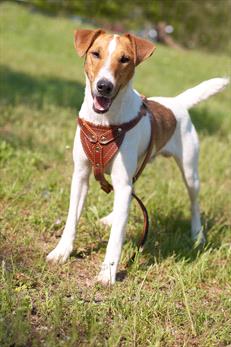Dog with Harness

Photo Courtesy Deposit Photos
In male dogs, the prostate is a gland that produces nutrients to help sperm survive once inside the female’s reproductive tract. The prostate gland surrounds the opening of his urinary bladder, which collects urine, as well as the urethra, a tube-like structure that sends urine from the bladder to outside the body.
Cancer Types
Within the prostate gland, cancer is rare, occurring in only about 0.3-0.6% of dogs. Cancer can originate in the prostate gland itself, which is called primary prostate cancer, or from another organ that spread, or metastasized, to the prostate. Most primary prostate cancers are aggressive and highly metastatic cancers. This means that they damage the tissues and grow and spread quite quickly. Prostatic adenocarcinoma is the most common type of primary cancer in the canine prostate.
Benign, or noncancerous tumors (e.g. leiomyoma), can occur in the prostate, but these are rare. Cancers that have spread from elsewhere in the body are also uncommon but can include lymphoma, which is associated with the immune system, and transitional cell carcinoma, a common cancer found in and around the bladder.
Causes of Prostate Cancer
Researchers have not been able to discover the cause of prostate cancer. Some research studies have suggested that neutered dogs are more likely to develop prostate cancer than un-neutered (i.e. intact) dogs. This finding does not necessarily mean that neutering causes the cancer. Neutered dogs tend to have a longer lifespan and receive better veterinary care, so it’s possible that intact dogs could develop prostate cancer equally under different conditions. Of course, plenty of intact male dogs are well-cared for and life long and happy lives, so many more research studies are needed to prove this theory one way or the other. What is important about this information is that both neutered and un-neutered dogs can get prostate cancer.
Symptoms
Symptoms may include urinating only small amounts at a time; urinating more often than usual; and/or straining to urinate (trying to go without success). The urine may be dark brown or blood-tinged. Blood may drip from the penis. If the prostate is enlarged, it could be pressing on the colon, which collects feces (poop), making it difficult for him to poop. You may notice that your dog positions himself to defecate more frequently or takes a long time to poop.
Sometimes the symptoms are less obvious. You may notice that your dog is losing weight or appears thinner. He may eat less or skip multiple meals. He may also lay around more or have trouble walking. In early stages of prostate cancer, your dog may not show any symptoms at all.
Diagnosis
If you suspect your dog has prostate cancer, he will need a thorough physical examination by a veterinarian. The vet will assess his overall health, feel his stomach to check for pain and abnormal structures, and perform a rectal examination to feel the prostate gland and any enlarged lymph nodes that could indicate cancer.
X-rays will likely be a next step to check the size of the prostate and look for any other abnormalities such as signs of cancer spread. An abdominal ultrasound will allow the vet to see how the prostate looks and give a better impression of the cancer’s effects on the surrounding organs. Lab work may also be taken to ensure your dog’s internal organs are all working properly and that no changes have occurred.
A biopsy (i.e. or removal of a tissue sample) of the prostate is the only sure way to confirm that an abnormal prostate is cancerous. Not all enlarged or abnormal prostates are cancer. A veterinary pathologist will look at the cells from the tissue sample to diagnosis the cancer.
Treatment Options
Unfortunately, few effective treatment options for dogs with prostate cancer are available. Surgery is not always helpful because the cancer has often spread by the time it is discovered. Postoperative complications from surgery are often problematic for dogs and can include trouble holding urine (urinary incontinence) and narrowing of the urethra to the point of being unable to urinate. Radiation tends to damage the surrounding tissues too much to be useful in most cases. Most chemotherapy drugs and protocols have not been shown to increase a dog’s lifespan.
If your dog is diagnosed with prostate cancer, palliative or supportive care can help keep your pet comfortable. Canine nonsteroidal anti-inflammatory drugs (NSAIDs) can decrease pain and may also have an anti-cancer effect on prostate cancer. Antibiotics may be needed if urinary tract or prostate infections occur secondary to the cancer. If the prostate becomes large enough to prevent urinating, surgery to enlarge the urethral opening or create a different direction of urine flow may be needed. Quality of Life evaluation and end of life decisions should also be discussed with your veterinarian.
Luckily, prostate cancer is rare. Routine veterinary check-ups and physical examinations may lead to finding prostate cancer early. If your pet is showing any unusual signs or symptoms, always call your vet’s office for their advice and/or to schedule a check-up.